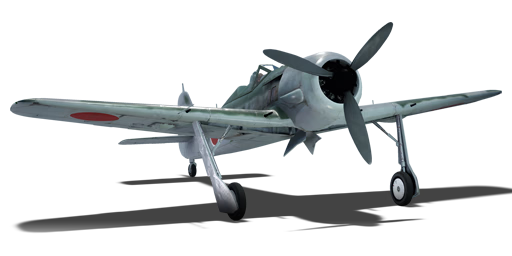


The Fw 190 A-5 (Japan) was loaned to the Japanese Army to examine its performance and design for their own IJAAS. The diving speed impressed them, but its agility disappointed, and Army decided not to produce or license more units. Instead, Kawasaki engineers learned from its features, especially its powerful air-cooled engine, which inspired the development of the Ki-100s engine that replaced the one in the Ki-61. The Army tested the Fw 190 against other foreign planes they had acquired, such as the Bf 109 E-7, P-51C 'Evalina' and their own domestic planes Ki-61 and the advanced Ki-84. They ranked the Fw 190 second after the P-51C, noting that its horizontal speed and maneuverability were not very impressive, while its diving speed was outstanding.
It has been in the game since the start of the Open Beta Test prior to Update 1.27 as the Fw 190 A-5/U3, but was renamed to Fw 190 A-5 in Update 1.35. Rocking four 20 mm cannons, an armoured radial engine and armoured fuel tanks, this aircraft is far but shy in the giving and taking role. Anything at 12 o'clock is soon to be smithereens. The wing root mounted cannons should be additionally placed on a separate key for head-on attacks. The outer-wing guns would only miss on distances of 800-1,000 m (~0.7 miles). This also helps for tricky shots, as the second pair of 20 mm guns only have 90 shots each, instead of the whopping 250 of the inner ones. But make sure to bring hell loose once the optimal firing solution is reached.
flaps
flaps
flaps
brake
| Belt | Belt filling | Armor penetration (mm) at a distance: | |||||
|---|---|---|---|---|---|---|---|
| 10 m | 100 m | 500 m | 1000 m | 1500 m | 2000 m | ||
| IT/HEI/APHE | 19 | 18 | 15 | 10 | 3 | 3 | |
| IT/HEI/HEI/APHE | 19 | 18 | 15 | 10 | 3 | 3 | |
| FI-T/HEI/HEI/FI-T/HEI/HEI/APHE | 19 | 18 | 15 | 10 | 3 | 3 | |
| IT | 10 | 10 | 5 | 2 | 1 | 1 | |
| APHE/HEI/HEI/HEI/AP-I | 20 | 17 | 10 | 5 | 3 | 2 | |
| Belt | Belt filling | Armor penetration (mm) at a distance: | |||||
|---|---|---|---|---|---|---|---|
| 10 m | 100 m | 500 m | 1000 m | 1500 m | 2000 m | ||
| IT/IT/APHE/HEI | 21 | 19 | 8 | 3 | 1 | 1 | |
| IT/HEI/HEI/AP-I | 27 | 24 | 14 | 7 | 3 | 2 | |
| AP-I/HEI/HEI/HEI/HEI/IT | 27 | 24 | 14 | 7 | 3 | 2 | |
| APHE/APHE/APHE/IT | 21 | 19 | 8 | 3 | 1 | 1 | |
| FI-T/FI-T/FI-T/IT/IT | 21 | 19 | 8 | 3 | 1 | 1 | |
| HEI/HEI/HEI/APHE/AP-I | 27 | 24 | 14 | 7 | 3 | 2 | |
| Belt | Belt filling | Armor penetration (mm) at a distance: | |||||
|---|---|---|---|---|---|---|---|
| 10 m | 100 m | 500 m | 1000 m | 1500 m | 2000 m | ||
| AP-T/AP-I/AI | 9 | 8 | 6 | 3 | 0 | 0 | |
| AP-T/AP/AI/AP-I | 13 | 12 | 7 | 3 | 2 | 0 | |
| AP-T | 9 | 8 | 6 | 3 | 0 | 0 | |
| AI/AP/AP/AP/AI | 13 | 12 | 7 | 3 | 2 | 0 | |







 2 x (85 / 235 / 410) %
2 x (85 / 235 / 410) % 
 2 x 160 %
2 x 160 % 

Flight performance | |
|---|---|
Survivability |
|---|
Weaponry | |
|---|---|